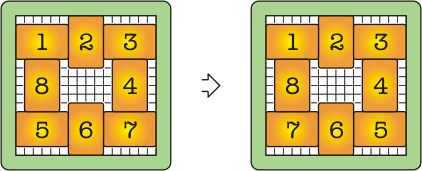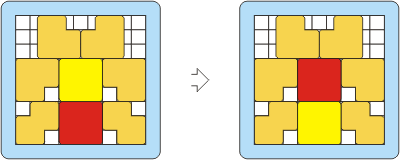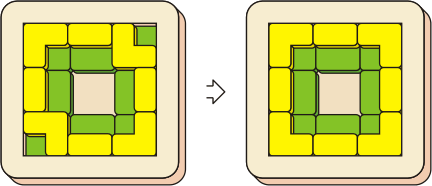 |
| |
A Colorful Journey through Endless Patterns of Quick Wits |
|
|
|
|
|
|
|
Home /
Theory /
How to Outwit the Parity |
|
|
|
|
|
|
Everyone who has ever tried to
solve Loyd's "14-15" puzzle very soon felt some invisible force that prevents to
solve the puzzle. And this force is so stubborn, so
strong that one might continue attempts to eternity
without success. The name of this force is
the Parity. Many mathematicians and puzzlers know this
"Invisible Thing" as a very dangerous, but at the same
time very useful force which sometimes helps to solve
very difficult problems (often with easy). Other times
it suggests the most unusual and puzzling challenges,
like Loyd's "14-15" puzzle that led the whole World to
incredible puzzle madness.
A parity principle is often
used as a main trick in sliding block puzzles, and is
the solving key for them. For many such "tricky" puzzles
solving them means finding the way how to change parity
of their pieces from odd to even. So once the solver
changes the parity of the pieces, the puzzle becomes
solvable.
Many puzzle inventors employ tricky ideas how to change
parity, and then mask these ideas from the solver in
order to make these puzzles appear unsolvable. Most of
such designs have a pair of identical interchangeable
pieces. So when you change these pieces in the final
position you, in fact, change the parity of the puzzle,
and reach the solution. Other designs have pieces with
special depictions, and when you rotate the whole puzzle
180°, some signs are changing into other and vice versa.
This way you may interchange one pair (or any odd number
of pairs) of pieces, and therefore "change" the parity
without really changing it. Yeah! So illusive.
Trickier still are designs which require that you rotate
the whole puzzle 90°. Actually, in this way you rotate
cycles with an even numbers of pieces, and again this
change the parity of the puzzle. Generally speaking,
every such tricky puzzle always requires to perform some
kind of optical illusion, because every time you have to
move some piece(s) into certain positions for which
another piece(s) would normally reside.
Nevertheless there is a method to outwitting the Parity
in a straightforward way, which does not require you to
rotate the whole puzzle, nor to interchange the
identical pieces, nor to use any special tricky
pictures.
I would like to show some sliding block
puzzles with this principle. Each of them uses pieces
with some special adjustments to their shapes. For all
the puzzles only usual rules for such type of puzzles
are allowed -- you may move pieces within a tray with no
turning, rotating, or lifting. For each puzzle its
starting position is shown always on the left, final one
on the right, and an arrow is placed between the
positions.
|
|
|
|
|
|
The Sliding Weave Puzzle |
|
You have the eight rectangular
pieces (each is 4x6) with numbers from 1 to 8. The
object is to exchange pieces 5 and 7. |
|
|
|
|
|
 |
The Sliding Weave Puzzle.
|
|
|
|
|
|
|
|
The Fan Puzzle |
|
You have eight identically shaped
pieces with one corner (1/8 of the full square's area)
cut. The object is to reverse the whole fan. |
|
|
|
|
|
 |
The Fan Puzzle.
|
|
|
|
|
|
The Beetle Puzzle |
|
You have the eight pieces as
following: two color square pieces, four pieces without
one corner (1/9 of the full square's area) and two
pieces without two corners (2/9 of the full square's
area). The object is to exchange the two color squares
on Beetle's back. |
|
|
|
|
|
 |
The Beetle Puzzle.
|
|
|
|
|
|
The Flexible Frame Puzzle - A |
|
You have the eight two-layered
pieces as following: four identical pieces are each made
by pasting two identical triominoes together, and four
other identical pieces are each made by pasting a half
square atop a square. The object is to exchange the
position of the two corner pieces, restoring a square
frame. |
|
|
|
|
|

|
 |
 |
|
|
|
|
4 corner pieces. |
4 edge pieces. |
|
The Flexible Frame Puzzle - A.
|
|
|
|
|
|
|
| |
|
|
|
|
|
Last
Updated: December 3, 2009
Posted: November 22, 2005 |
|
|
|
|
|
|
|
|
|
